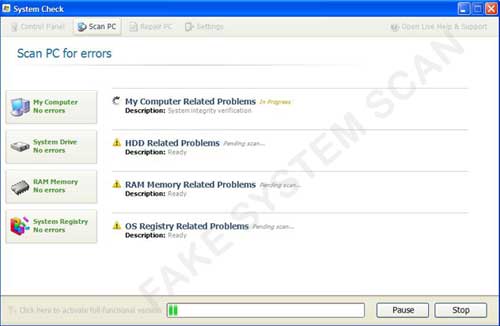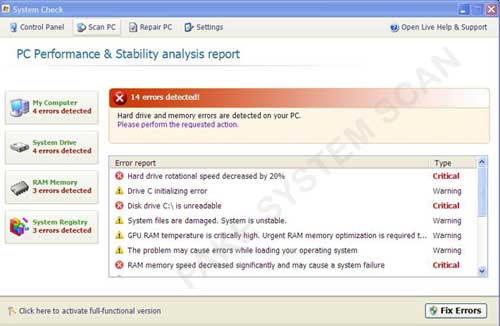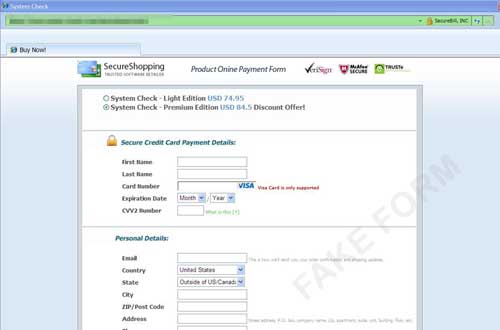TROJ_FAKEAV.FJV
Windows 2000, Windows XP, Windows Server 2003


Threat Type: Trojan
Destructiveness: No
Encrypted: Yes
In the wild: Yes
OVERVIEW
This Trojan may be unknowingly downloaded by a user while visiting malicious websites. It may be manually installed by a user.
TECHNICAL DETAILS
Arrival Details
This Trojan may be unknowingly downloaded by a user while visiting malicious websites.
It may be manually installed by a user.
Installation
This Trojan drops the following files:
- %Application Data%\{random}
- %Application Data%\~{random}
- %Application Data%\~{random}{random char}
- %Application Data%\Microsoft\Internet Explorer\Quick Launch\System Check.lnk
- %User Profile%\Desktop\System Check.lnk
(Note: %Application Data% is the current user's Application Data folder, which is usually C:\Windows\Profiles\{user name}\Application Data on Windows 98 and ME, C:\WINNT\Profiles\{user name}\Application Data on Windows NT, and C:\Documents and Settings\{user name}\Local Settings\Application Data on Windows 2000, XP, and Server 2003.. %User Profile% is the current user's profile folder, which is usually C:\Windows\Profiles\{user name} on Windows 98 and ME, C:\WINNT\Profiles\{user name} on Windows NT, and C:\Documents and Settings\{user name} on Windows 2000, XP, and Server 2003.)
It drops the following copies of itself into the affected system:
- %Application Data%\{random}.exe
(Note: %Application Data% is the current user's Application Data folder, which is usually C:\Windows\Profiles\{user name}\Application Data on Windows 98 and ME, C:\WINNT\Profiles\{user name}\Application Data on Windows NT, and C:\Documents and Settings\{user name}\Local Settings\Application Data on Windows 2000, XP, and Server 2003.)
It creates the following folders:
- %Start Menu%\Programs\System Check
(Note: %Start Menu% is the current user's Start Menu folder, which is usually C:\Windows\Profiles\{user name}\Start Menu on Windows 98 and ME, C:\WINNT\Profiles\{user name}\Start Menu on Windows NT and C:\Windows\Start Menu or C:\Documents and Settings\{User name}\Start Menu on Windows 2000, XP, and Server 2003.)
Autostart Technique
This Trojan drops the following file(s) in the Windows User Startup folder to enable its automatic execution at every system startup:
- %Start Menu%\Programs\System Check\System Check.lnk
- %Start Menu%\Programs\System Check\Uninstall System Check.lnk
(Note: %Start Menu% is the current user's Start Menu folder, which is usually C:\Windows\Profiles\{user name}\Start Menu on Windows 98 and ME, C:\WINNT\Profiles\{user name}\Start Menu on Windows NT and C:\Windows\Start Menu or C:\Documents and Settings\{User name}\Start Menu on Windows 2000, XP, and Server 2003.)
Other System Modifications
This Trojan adds the following registry entries:
HKEY_CURRENT_USER\Software\Microsoft\
Windows\CurrentVersion\Internet Settings
WarnOnZoneCrossing = "0"
HKEY_CURRENT_USER\Software\Microsoft\
Windows\CurrentVersion\Internet Settings
WarnonBadCertRecving = "0"
HKEY_CURRENT_USER\Software\Microsoft\
Windows\CurrentVersion\Internet Settings
CertificateRevocation = "0"
NOTES:
Upon execution, this program displays a GUI that scans the system for errors.

After scanning, it prompts the user to fix the errors found:

However, it fails to fix all the fake errors and asks the user to purchase the software for the full version. The "Buy Now" page looks like the following:

It attempts to access the following URLs:
- http://{BLOCKED}eigol.com/britix/a
- http://{BLOCKED}eigol.com/britix/ar
- http://{BLOCKED}eigol.com/up.php?{base64 encoded data}
SOLUTION
Step 1
For Windows XP and Windows Server 2003 users, before doing any scans, please make sure you disable System Restore to allow full scanning of your computer.
Step 2
Identify and terminate files detected as TROJ_FAKEAV.FJV
- If the detected file is displayed in either Windows Task Manager or Process Explorer but you cannot delete it, restart your computer in safe mode. To do this, refer to this link for the complete steps.
- If the detected file is not displayed in either Windows Task Manager or Process Explorer, continue doing the next steps.
Step 3
Delete this registry value
Important: Editing the Windows Registry incorrectly can lead to irreversible system malfunction. Please do this step only if you know how or you can ask assistance from your system administrator. Else, check this Microsoft article first before modifying your computer's registry.
- In HKEY_CURRENT_USER\Software\Microsoft\Windows\CurrentVersion\Internet Settings
- WarnOnZoneCrossing = 0
- WarnOnZoneCrossing = 0
- In HKEY_CURRENT_USER\Software\Microsoft\Windows\CurrentVersion\Internet Settings
- WarnonBadCertRecving = 0
- WarnonBadCertRecving = 0
- In HKEY_CURRENT_USER\Software\Microsoft\Windows\CurrentVersion\Internet Settings
- CertificateRevocation = 0
- CertificateRevocation = 0
Step 4
Search and delete this file
- %Application Data%\{random}
- %Application Data%\~{random}
- %Application Data%\~{random}{random char}
- %Application Data%\Microsoft\Internet Explorer\Quick Launch\System Check.lnk
- %User Profile%\Desktop\System Check.lnk
- %Start Menu%\Programs\System Check\System Check.lnk
- %Start Menu%\Programs\System Check\Uninstall System Check.lnk
Step 5
Search and delete these folders
- %Start Menu%\Programs\System Check
Step 6
Scan your computer with your Trend Micro product to delete files detected as TROJ_FAKEAV.FJV. If the detected files have already been cleaned, deleted, or quarantined by your Trend Micro product, no further step is required. You may opt to simply delete the quarantined files. Please check this Knowledge Base page for more information.
Did this description help? Tell us how we did.


